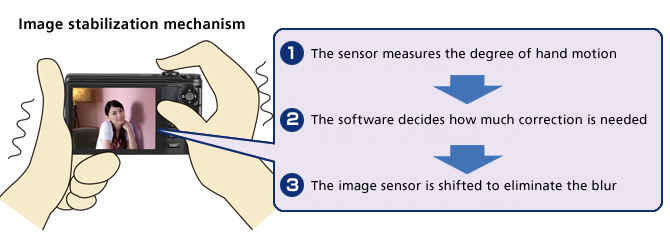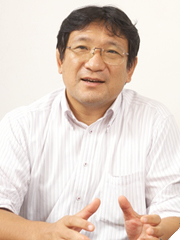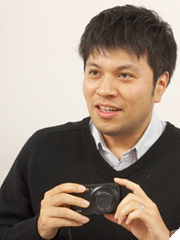Inside Story
- Planning
- Design and Development
- Sales and Marketing
Shoot the scene just the way you want with a top-level image stabilization function
On the CX4, in addition to achieving beautiful low-noise images, we installed the top-level image stabilization function in the compact digital camera field so that when you want to take a shot, you can just pull out the camera and capture the image as seen. In contrast to the “subject-motion blur Ethat occurs when the subject moves, “hand-motion blur Eoccurs when the photographer shifts the optical axis by inadvertently moving the camera when aiming or pushing the shutter release button. This hand-motion blur tends to occur particularly often when taking high-magnification telephoto shots and when shooting with long exposure times in dark places. To correct this blur, the following mechanism is used.


“For image stabilization precision, we
achieved the top level offered by Ricoh
cameras up to now. Ebr />(Toshiyuki Kobayashi)
“Human hand movement generally occurs at the very slow level of less than 15 vibrations per second (hertz). First of all, the degree of movement is detected by the sensor, then the amount of correction to be done is calculated and instructions given, and finally the sensor is shifted to the same degree as the hand motion so there is no relative motion between subject and sensor, Eexplained Toshiyuki Kobayashi, who worked on CX4 image stabilization in the Personal Multimedia Company ICS Design Office. Kobayashi made an all-out effort to increase the detection precision of the sensor. “Blur will not occur if the picture is taken by mounting the camera on a tripod, but our goal was a camera that can be pulled out and used whenever photographer wants to take a shot. We felt that strengthening image stabilization would widen the range of shooting possible so we tried very hard to do this on the CX4, Esaid Kobayashi.
Thorough probing of causes

“We began by thoroughly investigating the
causes of blurring. E(Koichi Muramatsu)
The level of this thoroughness can be seen in the persevering effort in which several thousand blurred photographs were intentionally taken and then carefully analyzed. “For the above three processes involved in hand-motion blur correction, we analyzed where the causes were for cases where blur could not be adequately corrected, Eexplained Personal Multimedia Company ICS Design Office member Koichi Muramatsu, who worked with Kobayashi on strengthening the image stabilization function. Was the precision of the sensor’s movement detection low? Did the software’s decision on the degree of correction not match reality? Or did the mechanism for image sensor movement not function adequately based on instructions from the software? “We even asked professional photographers to take pictures for us. It was really just one day after another of tracking down the causes of image blurring, Esaid Muramatsu.
The fact that the CX4 does not have a short focus lens added complexity to the analysis and increased the difficulty of cause identification. By using many numerical simulations, however, it became possible to efficiently tease out the causative factors. “Comparing simulation results with experiment results and checking the differences, we were able to differentiate between those areas performing as expected and those where phenomena outside the expected range were occurring. By repeating this work, we came to understand the causes of blur, Esaid Muramatsu.
Day after day, Muramatsu worked on the analysis by shutting himself in a darkened room and systematically changing shooting settings while taking pictures of a chart used for determining the degree of blurring. Camera vibration was also measured as part of the effort to help determine exactly what causes blurred images. “At the time, it was a straightforward and time-consuming repetitive task, but I coped with it by keeping in mind that it would enable us to achieve top-level image stabilization.
- Planning |
- Design and Development |
- Sales and Marketing


